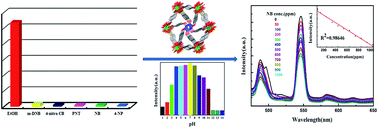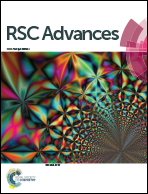A terbium metal–organic framework with stable luminescent emission in a wide pH range that acts as a quantitative detection material for nitroaromatics†
Abstract
Nitroaromatics are the principal components of explosives and infamous environmental pollutants in the organic synthesis industry. Although high sensitivity towards the detection of nitroaromatics have been demonstrated, selective and quantitative detection are critical for practical applications. Luminescent MOFs constructed by d10 transition metal ions (Zn/Cd) and π-conjugated ligands for nitro aromatics sensing have been widely reported, but the detection efficiency is insufficient due to the weak and non-characteristic luminescence behaviours. And, luminescent MOFs constructed by lanthanide ions which possess enhanced characteristic and strong luminescence emission for nitroaromatic detection are rare. Herein, we report a fluorescent MOF with stable emissions, [Tb(L1)2/3(L2)1/2(H2O)2]·2H2O (where H3L1 = 2,4,6-tris(4-carboxyphenoxy)-1,3,5-triazine, H2L2 = terephthalic acid), whose characteristic emission intensity can maintain more than 80% in a wide pH range (pH = 4–10). Interestingly, this luminescent MOF can quantitatively detect nitroaromatics.

- This article is part of the themed collection: RSC Advances Editors' collection: f Block Chemistry

 Please wait while we load your content...
Please wait while we load your content...